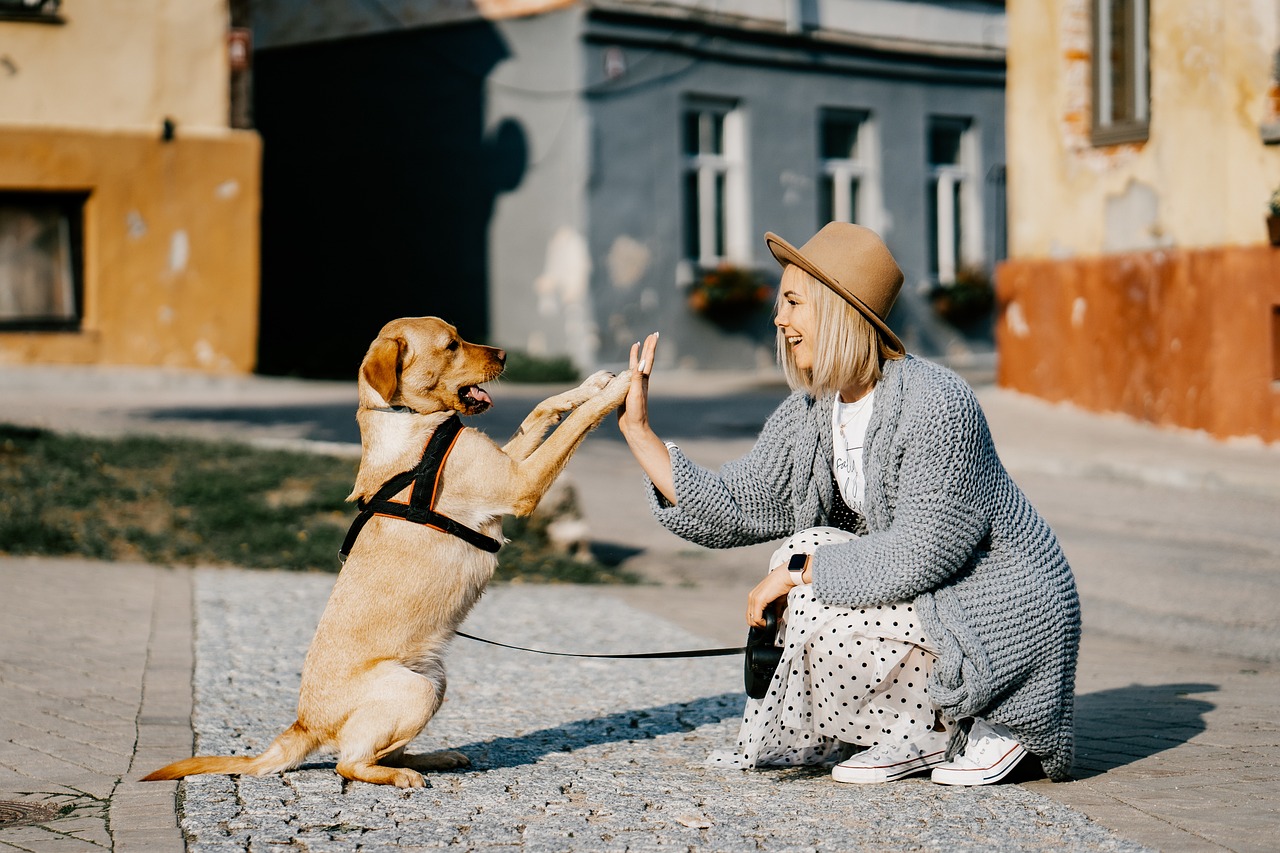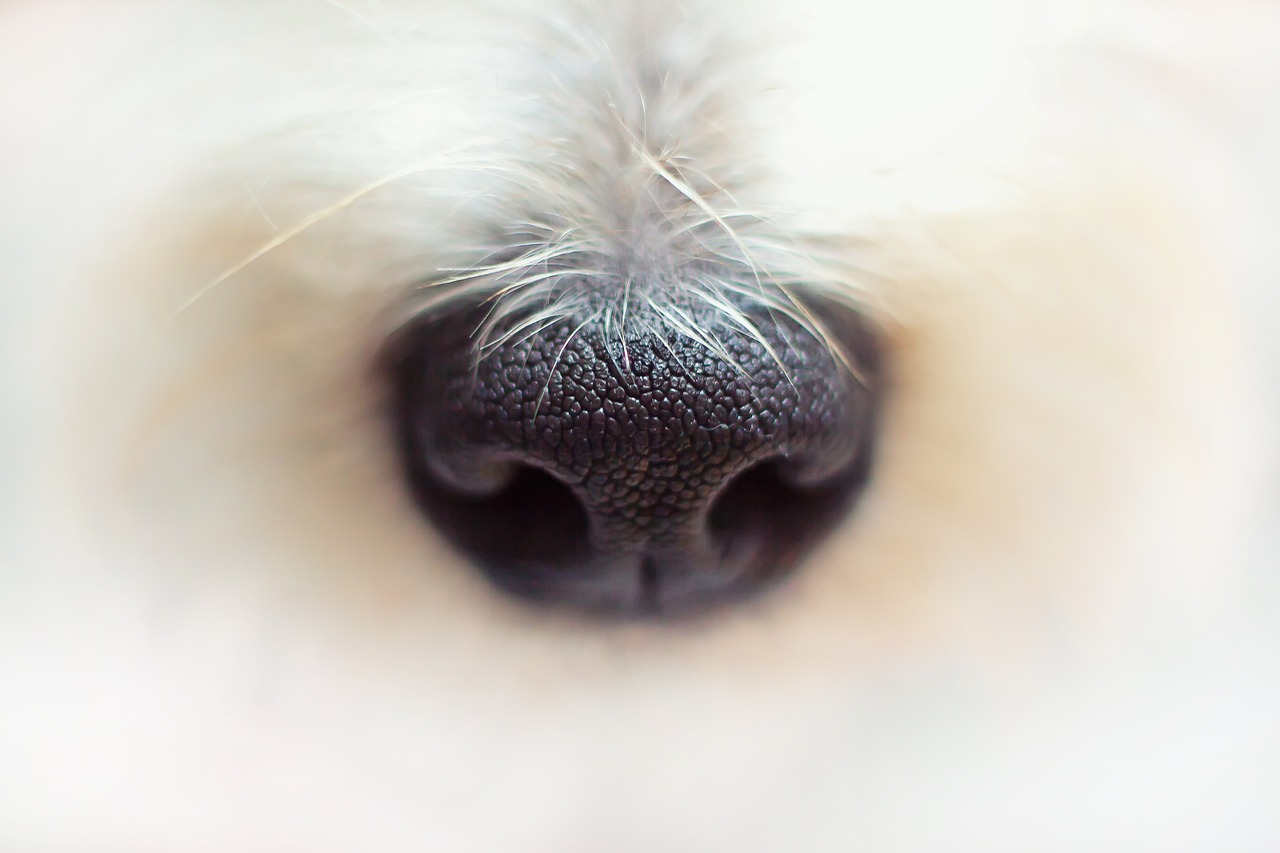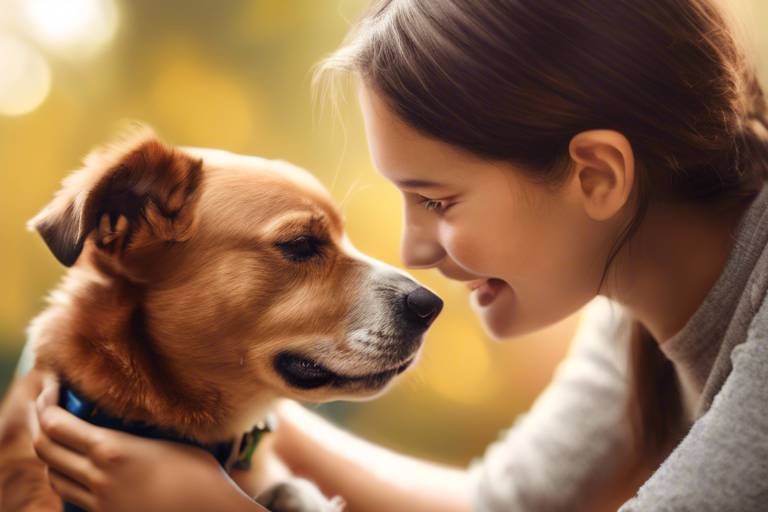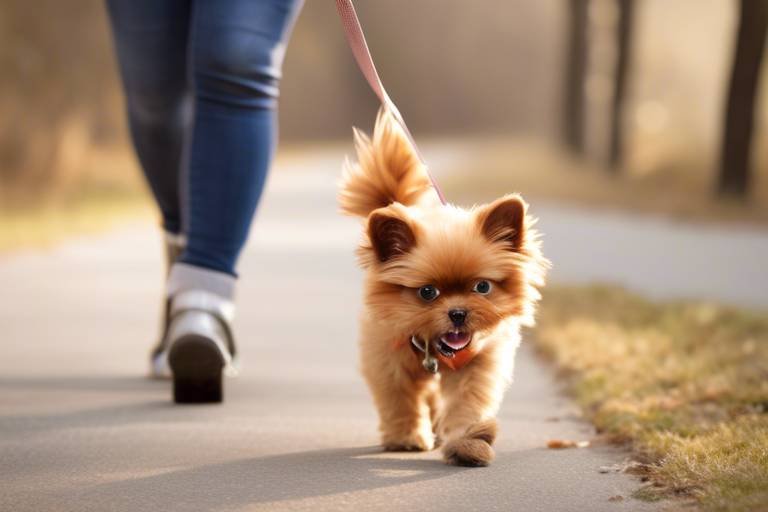Tips for Training Your Dog to Recognize Names of People
Training your dog to recognize the names of people can be an incredibly rewarding experience, both for you and your furry friend. Not only does it enhance communication, but it also strengthens the bond between you and your pet. Imagine walking into a room and your dog excitedly responding to the name of your friend, tail wagging and ready to greet them! This level of recognition is achievable with the right strategies and techniques. In this article, we will explore effective methods to help your dog learn to identify and respond to the names of people in their lives.
Before diving into the training methods, it’s essential to understand how dogs process information. Dogs have a remarkable ability to learn through association, which means they can connect a sound, like a name, with a person. By exploring how dogs perceive names and sounds, you can tailor your training approach to align with their natural instincts. For instance, dogs are more likely to respond to high-pitched, enthusiastic tones. This means that when you call a name, using a cheerful voice can significantly enhance their recognition.
The first step in training your dog to recognize names is selecting the right names for people. It’s crucial to choose names that are simple and distinct. Short names like "Max," "Sam," or "Liz" can be easier for your dog to learn compared to longer, more complex names. When dogs hear a name, they rely on the sound and rhythm, so unique names can minimize confusion. For example, if two people have names that sound similar, like "Matt" and "Pat," your dog might struggle to differentiate between them.
Using short and unique names can significantly improve your dog's ability to recognize individuals. Think of it as teaching a child their first words; the simpler the word, the easier it is to learn. By avoiding long names or complicated syllables, you can help your dog quickly associate the name with the person. For instance, instead of calling someone "Alexander," try using "Alex." This small tweak can make a world of difference in your dog's learning process.
When choosing names, it's vital to avoid names that sound alike. Dogs have a keen sense of hearing, but they can still get confused if the sounds are too similar. For example, if you have a friend named "Bill" and another named "Gill," your dog might mix them up. Instead, consider names that have distinct sounds and syllables. This will help ensure that your dog learns to respond accurately to each individual's name without any misunderstandings.
Consistency is key in any training process. Using the same names in similar contexts reinforces your dog's learning. If you call your friend "John" one day and "Johnny" the next, it may confuse your dog. Stick to the same name, and use it consistently when referring to that person. This repetition will help solidify your dog's understanding of who each person is, making it easier for them to respond appropriately.
Incorporating positive reinforcement during training sessions is one of the most effective ways to encourage your dog to learn names. Dogs thrive on rewards, so when they successfully recognize a name, offer them a treat, praise, or affection. This association of names with positive experiences creates a strong motivation for your dog to engage in the learning process. Imagine your dog’s excitement when they hear their favorite person’s name, followed by a tasty treat!
Regular practice and repetition are essential for reinforcing your dog's understanding of names. Just like humans need to hear and use a new word several times before it sticks, your dog requires consistent exposure to the names of people. Make it a part of your daily routine. Call out names during playtime or while giving commands. The more they hear the names, the better they will become at recognizing them.
Keeping training sessions short and engaging is crucial. Dogs have a limited attention span, so lengthy sessions can lead to boredom or frustration. Aim for training sessions of about 5-10 minutes, filled with enthusiasm and energy. This approach not only maintains your dog's interest but also allows for more effective learning without overwhelming them. Think of it as a quick, exciting game rather than a chore.
Using games that involve name recognition can make training fun and interactive. For example, you can play a game of hide and seek, where you call out a person's name, and your dog has to find them. This not only reinforces their understanding of names but also encourages them to engage actively in the learning process. Games create a joyful atmosphere, making your dog more likely to remember and respond to names.
Regularly assessing your dog’s progress is vital. This helps you identify areas that need improvement and ensures that your training remains effective. Pay attention to how your dog responds to different names. Are there names they struggle with? Are they consistently recognizing certain individuals? By keeping track of their progress, you can adjust your training methods accordingly, ensuring a tailored approach that suits your dog's learning pace.
Being flexible in your training techniques can enhance your dog's learning experience. If you notice your dog isn't responding well to a particular name, consider changing your approach. Perhaps try using a different tone or adding more positive reinforcement. Adapting your techniques based on your dog's responses can lead to improved results and a more enjoyable training experience for both of you.
Recognizing and celebrating your dog's achievements during training can significantly boost their confidence and motivation. Whether it's a small success like responding to a name or a big milestone like recognizing multiple names, celebrate it! Use treats, praise, or a fun play session as a reward. This positive reinforcement not only reinforces their desire to learn but also strengthens the bond between you and your furry friend.
- How long does it take for a dog to learn names? - The time it takes varies by dog, but with consistent practice, many dogs can start recognizing names within a few weeks.
- Can older dogs learn new names? - Absolutely! Dogs of all ages can learn new names, though it may take a bit more time and patience.
- What if my dog doesn’t respond to names? - If your dog isn’t responding, consider adjusting the name, using more positive reinforcement, or simplifying the training process.

Understanding Canine Cognition
Understanding how our furry friends think is crucial when it comes to training them to recognize names. Dogs are incredibly perceptive creatures, capable of picking up on cues from their environment and the people around them. They process information differently than humans, relying heavily on their senses, particularly smell and sound. While we might think of names as mere labels, to a dog, they represent a combination of sounds that they learn to associate with specific individuals. This understanding can significantly shape your training approach, allowing for a more effective and enjoyable learning experience.
Dogs primarily learn through associations. When you say a name, your dog not only hears the sound but also observes the context in which it is used. For instance, if you consistently call out "Sarah" while she’s giving your dog a treat, your pup will start to associate that name with positive experiences. This is why it’s essential to use names in a positive context, as it helps your dog develop a strong connection between the name and the person. The more positive experiences your dog has with a name, the more likely they are to respond to it.
Another fascinating aspect of canine cognition is their ability to differentiate between sounds. Dogs can hear a wider range of frequencies than humans, which helps them pick up on subtle differences in tone and pitch. This means that using a name with a distinct sound can aid in their recognition. For example, names like "Max" or "Bella" have clear, sharp sounds that are easier for dogs to identify compared to longer, more complex names.
Moreover, dogs thrive on routine. They are creatures of habit and often perform better when their training sessions are consistent and structured. By incorporating the same name for a person in similar situations, you reinforce their learning. For instance, if you always call "John" when he enters the room, your dog will start to recognize that sound as a signal that John is around. This consistency not only aids in name recognition but also strengthens the bond between your dog and the people in their life.
In addition to sound and routine, dogs are also highly attuned to body language and emotional cues. They can sense when you’re happy or frustrated, which can influence their learning process. If you’re excited when calling a name, your dog will pick up on that enthusiasm, making them more likely to respond positively. This emotional connection is vital in establishing trust and encouraging your dog to engage with the training process.
To summarize, understanding canine cognition involves recognizing how dogs process sounds, form associations, and respond to emotional cues. By tailoring your training methods to align with these natural instincts, you can significantly enhance your dog’s ability to recognize and respond to the names of people in their lives. Remember, it’s not just about the sound of the name; it’s about the experiences and emotions tied to it that make all the difference.
- How long does it take for a dog to recognize a name?
It varies by dog, but with consistent training, many dogs can recognize a name within a few weeks.
- Can all dogs learn to recognize names?
Yes, most dogs can learn to recognize names, though some breeds may be more adept due to their natural instincts.
- What if my dog doesn't respond to their name?
Try using positive reinforcement techniques and ensure you're using a name that is distinct and easy for them to recognize.

Choosing the Right Names
When it comes to training your dog to recognize names, the choice of names plays a crucial role in the success of your efforts. Think of it like picking the right tools for a job; the better the tools, the easier the job becomes! Choosing names that are simple and distinct can significantly enhance your dog's ability to differentiate between various individuals. Imagine trying to learn a new language where all the words sound similar; it would be confusing, right? The same applies to your furry friend!
To make the learning process smoother, opt for short and unique names. Names that are brief and have a distinct sound can help your dog quickly associate the name with the person. For instance, names like Max, Sam, or Liz are not only easy to say but also easy for your dog to recognize. On the flip side, names that are long or complicated can lead to confusion, making it harder for your dog to pick up on who you are referring to. Imagine trying to remember a name like Alexander when you could simply call someone Alex instead!
Another important factor is avoiding names that sound alike. This is crucial because if you have a friend named Bill and another named Gill, your dog might get mixed up. To prevent this, try to choose names that are phonetically different. For example, instead of naming two people Pat and Cat, consider using Pat and Tom. This way, your dog can easily distinguish between the two, reducing the chances of misunderstanding.
Consistency is key! Be sure to use the same names in similar contexts. If you constantly switch up names or use nicknames, your dog may struggle to connect the name to the person. For instance, if you refer to your friend Jessica as Jess one day and Jessie the next, it can lead to confusion. Stick to one name to reinforce your dog's learning and solidify their understanding of who each person is.
In summary, when choosing names for people that your dog will learn to recognize, keep them short, unique, and distinct. Avoid names that sound alike and maintain consistency in your usage. By following these guidelines, you will create a solid foundation for your dog's name recognition training, making it easier for them to understand and respond to the people in their lives.
Short and Unique Names
This article provides effective strategies and techniques to help your dog learn to recognize and respond to the names of people, enhancing communication and bonding between you and your furry friend.
Exploring how dogs process information and recognize names can help you tailor your training approach, ensuring that your methods align with their natural learning abilities and instincts.
Selecting simple, distinct names for people can facilitate your dog's learning process, making it easier for them to differentiate between various individuals and respond accurately to commands.
When it comes to training your dog to recognize names, are your best friends. Think about it: just like humans, dogs can find it challenging to differentiate between names that are too long or sound similar. Imagine trying to remember a friend's name that was a mouthful—it's not easy! By choosing names that are concise and distinct, you give your dog the best chance to make a solid connection between the name and the person.
For instance, names like Max, Lucy, or Ben are not only easy to say but also easy for your dog to recognize. In contrast, names like Alexander or Elizabeth may confuse them. The simpler the name, the quicker your furry friend can learn it. This is particularly important when you're trying to teach your dog to respond to multiple names in a social setting.
Moreover, consider the sounds that make up the names. Dogs are particularly sensitive to certain phonetic patterns. For example, a name like Sam is short, unique, and has a clear sound that is easy for dogs to pick up. On the other hand, names like Tom and Tim may sound too similar, leading to confusion during training sessions. To avoid this, try to select names that have distinct phonetic endings or syllables.
Additionally, consistency is key. Once you've chosen the names, use them consistently in similar contexts. For example, if you are calling out to your friend John, make sure to always use "John" and not mix it up with "Johnny" or any other variation. This consistency will help your dog solidify their understanding of who each person is, making it easier for them to respond accurately.
Incorporating positive reinforcement during training sessions encourages your dog to associate names with rewards, making the learning process enjoyable and effective for them.
Regular practice and repetition are essential for reinforcing your dog's understanding of names, helping to embed the recognition in their memory through consistent exposure.
Keeping training sessions short and engaging can maintain your dog's interest and focus, allowing for more effective learning without overwhelming them.
Using games that involve name recognition can make training fun, encouraging your dog to engage actively while reinforcing their understanding of the names of people.
Regularly assessing your dog’s progress can help you identify areas that need improvement, ensuring that your training remains effective and tailored to your dog's learning pace.
Being flexible and willing to adjust your training techniques based on your dog's responses can enhance their learning experience and improve overall results.
Recognizing and celebrating your dog's achievements during training can boost their confidence and motivation, reinforcing their desire to learn and respond to names.
- How long does it take for a dog to learn names? - Every dog is different, but with consistent training, many dogs can start recognizing names within a few weeks.
- Can I use nicknames instead of full names? - Yes! As long as the nickname is unique and consistent, your dog can learn to respond to it.
- What if my dog doesn't respond to names? - Ensure that you are using positive reinforcement and that the names are distinct. It may take time and patience.
Avoiding Similar Sounds
When training your dog to recognize the names of people, one crucial aspect to consider is the sound of the names you choose. Dogs are incredibly perceptive creatures, and they can often be confused by names that sound alike. Imagine trying to distinguish between two friends named "Matt" and "Pat" – the similarity in sound can lead to misunderstandings. This is why it’s essential to select names that are distinct and easily recognizable.
To make this point clearer, let’s break down some examples of names that might cause confusion:
| Confusing Names | Recommended Alternatives |
|---|---|
| Sam | Jake |
| Bill | Ted |
| Kim | Lucy |
As you can see from the table above, opting for names that don’t share similar sounds can significantly reduce the likelihood of confusion. In this way, your dog will have a clearer understanding of who you are referring to when you call out a name. Think of it like teaching a child to recognize different fruits; if you keep presenting apples and oranges that sound the same, they might struggle to differentiate between the two. The same principle applies to your furry friend.
Furthermore, it’s important to maintain a consistent tone when using each name. Dogs are not just listening to the words; they’re also picking up on the emotional cues in your voice. If you use a similar tone for names that sound alike, it can further muddy the waters. So, when you call out a name, ensure that your tone is distinct and matches the name you’re using. This will help your dog connect the sound to the right person more effectively.
In summary, avoiding names that sound similar is a simple yet powerful strategy in your dog training toolkit. By choosing distinctive names and being mindful of your tone, you can help your dog learn to recognize and respond to the names of the people they love. This not only enhances communication but also strengthens the bond between you and your furry companion.
- How long does it take for a dog to learn names? - It varies by dog, but with consistent training, many can learn several names within a few weeks.
- Can I use nicknames instead of full names? - Yes, as long as the nickname is distinct and consistently used, dogs can learn to recognize them.
- What if my dog seems confused? - If your dog appears confused, consider simplifying the names used or ensuring that your tone is clear and consistent.
Consistency in Usage
When it comes to training your dog to recognize names, consistency is key. Just like humans, dogs thrive in environments where they can predict outcomes based on repeated experiences. If you consistently use the same name for a person in similar contexts, your dog will start to associate that name with the individual, making it easier for them to respond appropriately. For instance, if you always refer to your friend Sarah as "Sarah" when she enters the room, your dog will quickly learn to recognize her name and react when called.
Imagine trying to learn a new language and hearing the same word pronounced differently each time. Confusing, right? That’s how your dog feels when you switch up names or use nicknames. To enhance your dog's learning experience, consider the following tips:
- Use the same tone: Dogs are sensitive to vocal tones, so keep your tone consistent when calling out names.
- Context matters: Always use names in similar situations to reinforce the association. For example, if you call "Mom" when she’s in the kitchen, do it every time she’s in that space.
- Avoid distractions: When training, minimize distractions to help your dog focus solely on the name being used.
By creating a consistent environment, you’re not just teaching your dog names; you’re also building a stronger bond. They’ll feel more secure knowing what to expect, which can lead to a happier, more responsive dog. Remember, patience is essential. Just like any learning process, it takes time for your dog to fully grasp the concept. Celebrate small victories along the way, and don’t hesitate to repeat the names often. This repetition will help cement their understanding.
As you progress, keep in mind that consistency also involves everyone in your household. If multiple people are calling your dog, ensure that they all use the same names and tones. This unified approach will prevent confusion and help your dog learn more effectively. After all, a well-trained dog is a happy dog, and with the right consistency, you’ll see incredible results in your dog’s ability to recognize and respond to names.
Q: How long does it take for my dog to learn to recognize names?
A: The time it takes varies by dog, but with consistent training, most dogs can start recognizing names within a few weeks.
Q: Can I use nicknames for my dog's training?
A: While nicknames can be fun, it's best to stick with the original names during training to avoid confusion.
Q: What if my dog doesn’t respond to a name?
A: If your dog isn’t responding, try using treats or toys to create a positive association with the name.
Q: Should I train my dog to recognize names of all family members?
A: Yes! Training your dog to recognize the names of all family members can enhance communication and strengthen your bond.
Positive Reinforcement Techniques
When it comes to training your dog to recognize the names of people, positive reinforcement is your best friend! This method is not just about giving treats; it’s about creating a joyful and rewarding environment that encourages your furry companion to learn and respond. Imagine your dog’s tail wagging with excitement every time they hear a name they recognize. That’s the power of positive reinforcement! By associating names with rewards, you’re not only teaching them but also building a stronger bond.
So, how do you effectively implement positive reinforcement in your training sessions? Start by using a variety of rewards that resonate with your dog. This could include treats, praise, or even their favorite toy. For instance, when your dog successfully responds to a person’s name, shower them with affection and a tasty treat. This creates a clear connection in their mind: “When I recognize this name, I get something awesome!”
Moreover, the timing of your rewards is crucial. To reinforce the behavior effectively, you should reward your dog immediately after they respond to the name. This helps them make the association between the name and the reward. You can think of it like a game where the faster you react, the more fun it is! Consistency is key here; always reward them when they get it right, and they’ll be more likely to repeat the behavior.
Additionally, consider using a clicker as a training tool. A clicker can serve as a bridge between the behavior and the reward. When your dog hears the click, they know they’ve done something right, and they can then anticipate a reward. This method can be particularly effective in noisy environments where verbal praise might get lost. The clicker becomes a distinct sound that your dog learns to associate with positive outcomes.
It’s also important to remember that every dog is unique. Some might respond better to verbal praise, while others may prefer physical affection or toys. Pay attention to what motivates your dog the most and tailor your approach accordingly. For example, if your dog lights up at the sight of their favorite ball, use that as a reward for recognizing names. This personalized touch can make a world of difference in their learning experience.
Lastly, don’t forget to celebrate the small victories! When your dog successfully recognizes a name, make it a big deal. Jump up and down, cheer, and give them an extra treat. This not only reinforces their learning but also makes the training process enjoyable. Remember, training should be a fun experience for both you and your dog!
- How long does it take for a dog to recognize names? - It varies by dog, but with consistent training, many dogs can start recognizing names within a few weeks.
- Can I use negative reinforcement? - It's generally discouraged, as it can create fear and anxiety. Positive reinforcement is more effective and fosters a better bond.
- What if my dog doesn’t respond to positive reinforcement? - Try different rewards and ensure you’re being consistent. Some dogs may need more time or different types of motivation.
- Is it better to train with distractions around? - Start in a quiet environment and gradually introduce distractions to help your dog learn to focus amidst chaos.

Practice and Repetition
When it comes to training your dog to recognize the names of people, practice and repetition are your best friends. Just like us, dogs thrive on consistency, and the more they hear a name, the easier it becomes for them to associate it with the right person. Imagine trying to learn a new language without ever practicing it; it would be nearly impossible! Similarly, your furry friend needs to be exposed to names repeatedly in order to truly grasp their meanings.
One effective way to incorporate practice into your routine is to make it a part of your daily interactions. For instance, when your friend visits, make sure to call them by name while giving your dog a treat. This method not only reinforces the name but also creates a positive association in your dog’s mind. You might think of it as a game; every time they hear the name and respond appropriately, they get rewarded. Rewarding good behavior is key to making the learning process enjoyable.
Additionally, keeping your training sessions short and engaging is crucial. Dogs have a limited attention span, so aim for sessions that last around 5 to 10 minutes. This is enough time to reinforce learning without overwhelming them. For example, you can practice name recognition during playtime or while on walks. By integrating training into fun activities, your dog will be more likely to stay focused and engaged.
Incorporating games is another fantastic way to encourage practice and repetition. You can play a simple game where you call out a name and reward your dog when they respond correctly. You could even set up a small obstacle course and have different people stand at various points, calling out their names. This not only makes the training fun but also adds an element of excitement that keeps your dog eager to learn.
Finally, remember that patience is essential. Just like any skill, learning to recognize names takes time. Celebrate small victories along the way, whether it’s your dog turning their head when they hear a name or coming to you when called. Each step forward is a step closer to achieving your goal. So, keep practicing, stay consistent, and watch as your dog becomes a name-recognition pro!
- How long does it take for a dog to learn names?
Every dog is different, but with consistent practice and positive reinforcement, many dogs can start recognizing names within a few weeks.
- Can older dogs learn to recognize names?
Absolutely! Dogs of all ages can learn new things, including recognizing names, as long as the training is consistent and engaging.
- What if my dog doesn't respond to a name?
It may be necessary to adjust your training techniques. Ensure you are using positive reinforcement and consider simplifying the names you are using.
Short Training Sessions
When it comes to training your dog, are the secret sauce to success. Imagine trying to teach a child a new concept in a classroom that feels like an eternity. They’d likely lose interest, right? The same goes for our furry friends. Dogs have a limited attention span, and lengthy training sessions can lead to frustration for both you and your pup. Instead of overwhelming them, aim for 10 to 15-minute sessions that keep your dog engaged and eager to learn.
During these brief periods, focus on one specific command or name recognition task. For example, if you're working on your dog's ability to recognize a family member's name, dedicate a session to that alone. Use plenty of enthusiasm and energy to keep things lively! You can even incorporate their favorite toy or treat as a reward, making the experience more enjoyable. Remember, the goal is to create a positive association with the name, so keep it fun!
Another effective strategy is to break down the training into smaller, manageable chunks. This means you can mix up the activities each day. One day, focus on recognizing the name "Sarah," and the next session, switch to "John." This variety helps your dog stay interested and reinforces their learning without the risk of burnout. Plus, it gives you the opportunity to celebrate small victories, which can be incredibly motivating for both you and your pup.
To illustrate the effectiveness of short training sessions, consider the following table:
| Training Session | Duration | Focus Area |
|---|---|---|
| Session 1 | 10 minutes | Recognizing "Sarah" |
| Session 2 | 15 minutes | Recognizing "John" |
| Session 3 | 10 minutes | Review of both names |
By keeping training sessions short, you not only maintain your dog's attention but also create a more effective learning environment. Just like a well-cooked meal, the right timing can make all the difference. So, next time you sit down to train your dog, remember: less is more. Celebrate those small wins and watch as your dog's ability to recognize names grows stronger with each session!
- How often should I conduct training sessions? - Aim for multiple short sessions throughout the week, ideally 2-3 times a day.
- What if my dog seems disinterested? - Switch up the activities or take a break. Sometimes, dogs just need a little downtime to recharge.
- Can I train my dog to recognize names of other pets? - Absolutely! The same principles apply. Just remember to keep it fun and engaging.
Incorporating Games
Training your dog doesn't have to be a monotonous task filled with repetitive commands and dry sessions. Instead, why not spice it up by incorporating games into your training routine? Dogs are naturally playful creatures, and tapping into that playfulness can create a fun learning environment. Think of it this way: if you were learning a new skill, would you prefer a boring lecture or an interactive workshop? The same goes for your furry friend!
One effective game is the classic "Name Game." In this activity, gather a few friends or family members, each with a distinct name. Start by calling out one person's name while holding a treat. When your dog responds correctly—by looking at the person or coming towards them—reward them with the treat and lots of praise. This not only reinforces their understanding of names but also strengthens the bond between your dog and the people in your life.
Another game you can play is "Hide and Seek." This game is both mentally stimulating and exciting for your dog. Have a family member hide in a different room and call out their name. Encourage your dog to find them. When they do, shower them with affection and treats. This game not only helps your dog learn to recognize names but also enhances their problem-solving skills. It's a win-win!
Incorporating games into your training sessions can also help your dog associate names with positive experiences. For instance, you can create a mini obstacle course where each section is associated with a different person's name. As your dog navigates the course, call out the names, and reward them when they reach the correct person. This adds an element of excitement and adventure to the learning process.
Don't forget to keep the games varied and engaging. Dogs can easily lose interest, so mixing up the activities will keep them on their toes. You could try using toys, like a ball or a frisbee, where you call out a name before tossing the toy to the designated person. This not only makes it fun but also helps your dog learn to associate the name with the individual in a lively way.
Ultimately, the key to incorporating games into your dog's training is to ensure that they are enjoyable and rewarding. This way, your dog will look forward to training sessions, making it easier for them to learn and remember the names of people in their lives. So grab some treats, gather your friends, and get ready to turn training into a fun-filled adventure!
Q: How long should I play these games with my dog?
A: It's best to keep play sessions short and engaging, around 5 to 10 minutes, to maintain your dog's interest.
Q: Can I use these games for other types of training?
A: Absolutely! Many of these games can be adapted for other training purposes, such as teaching commands or tricks.
Q: What if my dog doesn't respond to the games?
A: If your dog seems uninterested, try changing the game or the rewards. Some dogs respond better to different types of treats or play styles.
Q: How can I tell if my dog is enjoying the games?
A: Look for signs of excitement, such as wagging tails, playful barks, or eager body language. If your dog seems engaged and happy, they're likely enjoying the activity!

Monitoring Progress
Monitoring your dog's progress is a crucial aspect of training, especially when it comes to recognizing the names of people. Just like humans, dogs learn at different paces, and keeping track of their development can help you fine-tune your training methods. Think of it as being a coach for your furry friend; you need to know when to push them harder and when to ease off. Regular assessments not only help you identify areas that need improvement but also allow you to celebrate the little victories along the way.
One effective way to monitor progress is by keeping a training journal. In this journal, you can note down your dog's responses to different names, how quickly they react, and any challenges you encounter. For example, if your dog consistently responds to the name "Max" but struggles with "Sophie," this observation can guide you in adjusting your training approach. You might want to focus more on "Sophie" during your sessions until you see improvement.
Additionally, incorporating specific milestones can provide clear indicators of your dog's learning journey. Consider setting up a simple table to track their progress over time:
| Date | Name Tested | Response Time | Comments |
|---|---|---|---|
| 01/10/2023 | Max | 1 second | Excellent response! |
| 01/10/2023 | Sophie | 3 seconds | Needs improvement. |
| 01/15/2023 | Max | 0.5 seconds | Very quick! |
| 01/15/2023 | Sophie | 2 seconds | Better response. |
As you can see, this simple table can provide a visual representation of your dog's progress, making it easier to identify trends and areas that require additional focus. Don't forget to celebrate milestones, no matter how small! When your dog successfully recognizes a name or shows improvement, reward them with treats, praise, or extra playtime. This positive reinforcement not only boosts their confidence but also reinforces their desire to learn.
Moreover, don’t hesitate to adjust your techniques based on your dog’s responses. If you notice that your dog is struggling with certain names, try changing the environment, using different tones of voice, or even incorporating more engaging activities. Flexibility in your training approach can significantly enhance their learning experience. Remember, the goal is to create a fun and rewarding atmosphere where your dog feels motivated to learn and grow.
- How long does it take for a dog to recognize names?
Every dog is different, but with consistent training, many dogs start to recognize names within a few weeks. - What if my dog doesn’t respond to a name?
It could be due to confusion or similarity to other names. Try using a different name or adjust your training techniques. - Can I train my dog to recognize multiple names at once?
While it’s possible, it’s generally more effective to focus on one name at a time to avoid confusion.
Adjusting Techniques
When it comes to training your dog to recognize names, flexibility is key. Dogs, much like people, have their own unique learning styles and paces. This means that what works for one pup might not resonate with another. To truly enhance your dog's learning experience, you need to be willing to adapt your training techniques based on their responses. For instance, if your dog seems confused or uninterested, it might be time to switch things up a bit.
One effective way to gauge your dog's understanding is to observe their body language and reactions. Are they wagging their tail excitedly when they hear a name, or do they look puzzled? Paying attention to these cues can provide valuable insights into how your dog is processing the information. If you notice that a particular name is causing confusion, consider trying a different name or a new approach. For example, if your dog struggles with the name "Charlie," you might try using a nickname or a completely different name that sounds distinct.
Additionally, incorporating a variety of training methods can keep things fresh and engaging for your dog. You can try different types of rewards, such as treats, toys, or even verbal praise, to see what excites your dog the most. Mixing up the rewards can help maintain their interest and motivation. For example, if you usually use treats, try switching to a favorite toy for a session. This variation not only keeps your dog engaged but also reinforces the learning process by associating the name with different positive experiences.
It’s also essential to consider the environment in which you’re training. Some dogs may perform better in a quiet setting, while others thrive in a more stimulating environment. If your dog seems distracted during training, you might want to adjust the location or the time of day. Training during a quieter moment in the day, such as early morning or late evening, might yield better results. Remember, the goal is to create a positive and focused atmosphere that encourages learning.
Lastly, don’t forget to celebrate the small victories. When your dog responds correctly to a name, give them plenty of praise and perhaps a little treat. This not only reinforces their learning but also builds their confidence. Dogs love to please their owners, and positive reinforcement will encourage them to keep trying. So, be sure to recognize their efforts and adjust your techniques as needed to ensure that they feel successful in their training journey.
- How long does it take for a dog to learn names? - The time it takes varies by dog, but with consistent training, many dogs can learn to recognize names within a few weeks.
- What if my dog doesn’t respond to their name? - If your dog isn't responding, consider adjusting the name to something simpler or more distinct, and ensure you're using positive reinforcement.
- Can all dogs learn to recognize names? - Yes, most dogs can learn to recognize names, but some may take longer than others due to individual differences in learning styles.
Celebrating Milestones
Every time your dog masters a new name, it’s a cause for celebration! Just like humans, dogs thrive on positive reinforcement and recognition. When your furry friend successfully identifies a person's name, it’s essential to acknowledge that achievement. Celebrating these milestones not only boosts your dog’s confidence but also strengthens the bond between you two. So, how can you effectively celebrate these moments? Here are a few ideas:
- Verbal Praise: Use an enthusiastic tone and shower your dog with compliments. Simple phrases like "Good boy!" or "You did it!" can go a long way in making your dog feel proud.
- Physical Affection: A gentle pat on the head or a belly rub can be a great way to show your dog that you’re pleased with their progress. Dogs love physical touch, and it reinforces their good behavior.
- Special Treats: Consider giving your dog a favorite treat as a reward. This not only makes them happy but also creates a positive association with recognizing names.
- Playtime: Engage in a fun game or activity they enjoy. Whether it's fetching a ball or tugging on a rope, playtime can be a fantastic way to celebrate their success.
Moreover, keeping a training journal can be a wonderful way to track your dog’s progress. Documenting each milestone not only helps you recognize how far your dog has come but also allows you to share these moments with family and friends. You can create a simple table like the one below to log each name your dog learns and the date they mastered it:
| Name Learned | Date Mastered | Celebration Method |
|---|---|---|
| John | 2023-10-01 | Special Treat |
| Sarah | 2023-10-05 | Playtime |
| Mike | 2023-10-10 | Verbal Praise |
Remember, every little victory counts! Celebrating milestones not only encourages your dog to keep learning but also makes the training process enjoyable for both of you. So, don’t hold back on the celebrations; let your dog know just how proud you are of their achievements!
Q: How often should I celebrate my dog's milestones?
A: Celebrate every time your dog successfully learns a new name. Regular recognition keeps them motivated and engaged in the training process.
Q: What if my dog struggles to learn a name?
A: If your dog is having difficulty, be patient and adjust your training methods. Consider breaking down the learning process into smaller, manageable steps and celebrate small victories along the way.
Q: Can I use toys as rewards?
A: Absolutely! Using toys as rewards can be very effective. If your dog has a favorite toy, incorporating it into your celebrations can make the learning experience even more enjoyable.
Frequently Asked Questions
- How long does it take for a dog to recognize names?
Every dog is unique, so the time it takes for them to recognize names can vary. Generally, with consistent training and positive reinforcement, many dogs can start recognizing names within a few weeks. Just like us, some dogs may pick it up faster than others!
- Can I use nicknames when training my dog?
While using nicknames can be fun, it's best to stick with the original names during training. This helps avoid confusion, as dogs learn better with distinct, consistent sounds. Once they’ve mastered the original names, you can introduce nicknames if you wish!
- What if my dog doesn’t respond to names at all?
If your dog isn’t responding, don’t worry! It might be time to reassess your training methods. Ensure you’re using positive reinforcement, keeping training sessions short and engaging, and practicing regularly. Sometimes a little patience and creativity can do wonders!
- Is it okay to train multiple dogs to recognize names at the same time?
Training multiple dogs can be challenging, as they might get distracted by each other. It’s usually more effective to train them separately, focusing on one dog at a time. This helps each dog to concentrate and learn without distractions!
- How can I tell if my dog is making progress?
Look for signs like your dog responding correctly to names, showing excitement when called, or even looking at the person when their name is mentioned. Regular practice and celebrating small victories can also boost their confidence and motivation!
- What should I do if my dog seems frustrated during training?
If your dog appears frustrated, it’s a good idea to take a break. Training should be a fun experience! You can change the approach, use treats more liberally, or switch to a game that encourages name recognition to keep things light and enjoyable.



















